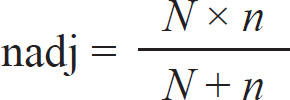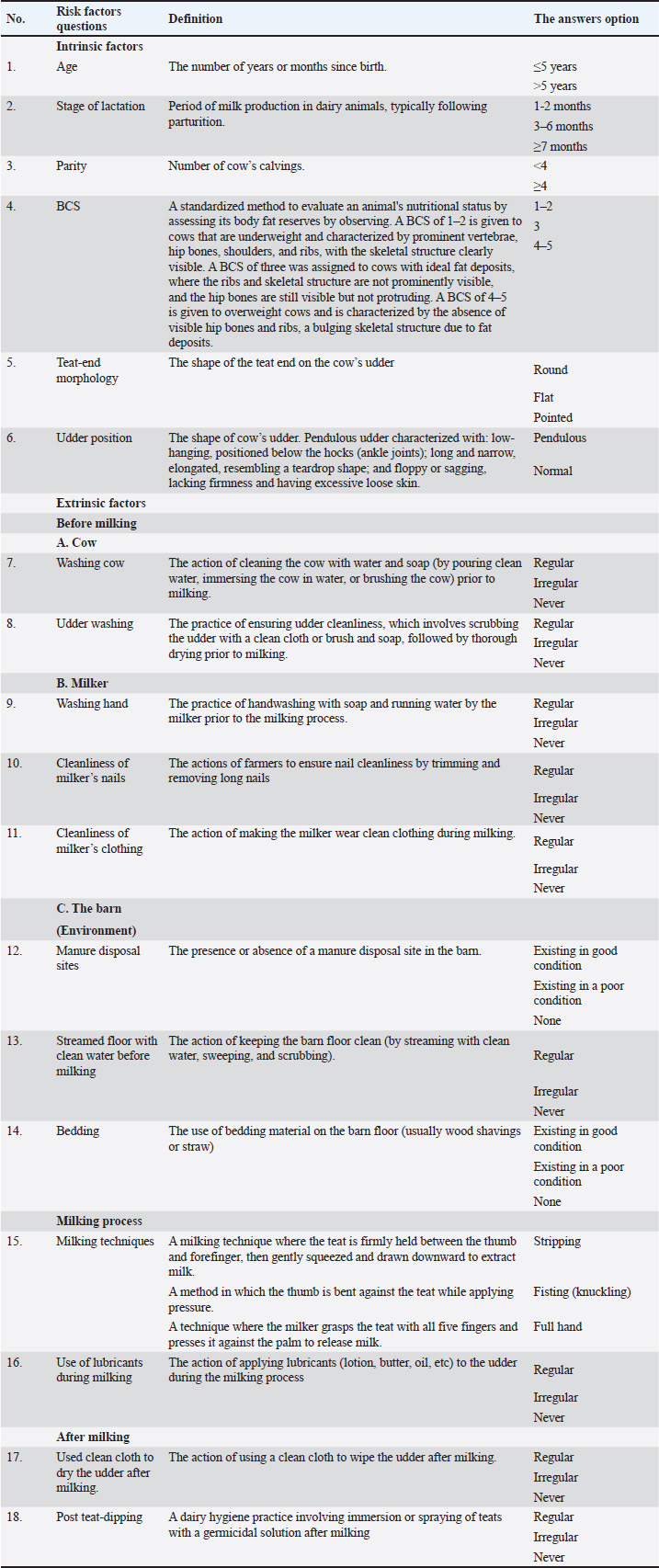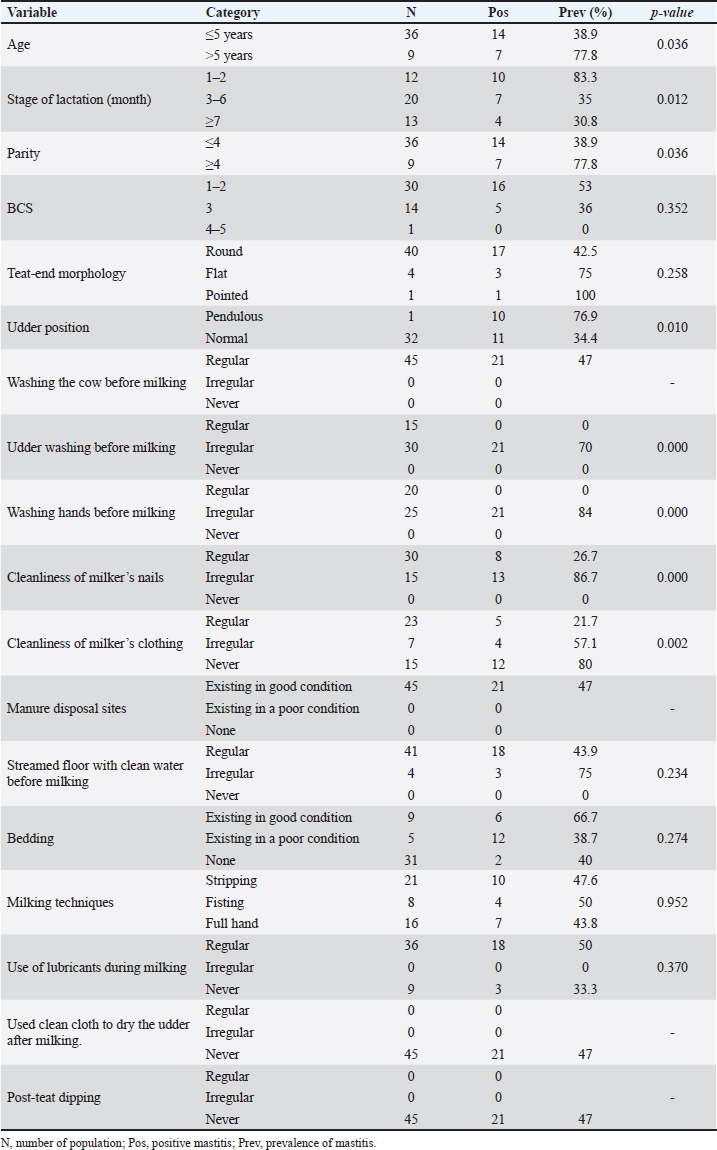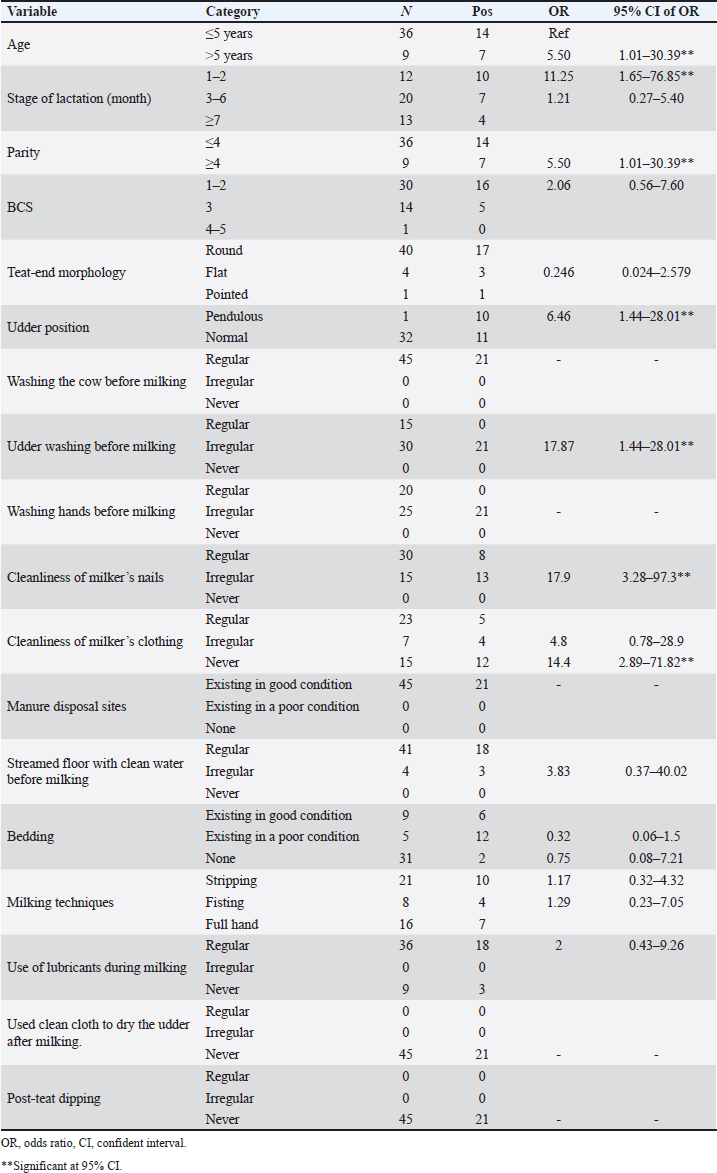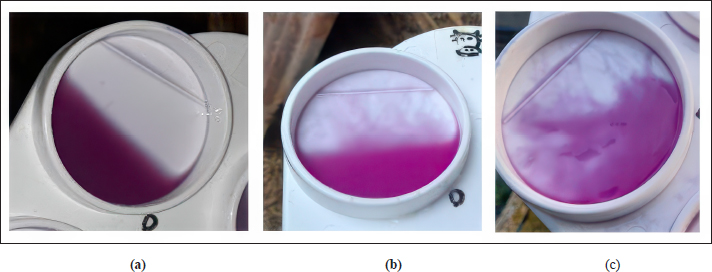
| Research Article | ||
Open Vet. J.. 2025; 15(2): 785-794 Open Veterinary Journal, (2025), Vol. 15(2): 785-794 Research Article Prevalence and risk factors of mastitis in Guranteng Dairy Farm, Tasikmalaya, IndonesiaRaida Raisatulhaq1*, Trianing Tyas Kusuma Anggaeni1 and Didin Supriat Tasripin21Veterinary Medicine, Universitas Padjadjaran, Sumedang, Indonesia 2Faculty of Animal Husbandary, Universitas Padjadjaran, Sumedang, Indonesia *Corresponding Author: Raida Raisatulhaq. Veterinary Medicine, Universitas Padjadjaran, Sumedang, Indonesia. Email: rraisatulhaq [at] gmail.com Submitted: 02/11/2024 Accepted: 12/01/2025 Published: 28/02/2025 © 2025 Open Veterinary Journal
AbstractBackground: Statistics indicate that fresh dairy product consumption in Indonesia will increase to 3.82 kg per capita by 2030. To meet the increased public demand for milk, dairy farmers must enhance their milk production and prioritize milk quality to ensure adequate nutrition for the public. Mastitis is a factor contributing to the low production and quality of milk. Mastitis is an inflammation of the udder that can be caused by infection. Aim: This study aimed to determine the prevalence and risk factors of mastitis in dairy cows at Guranteng Dairy Farm, Tasikmalaya, Indonesia. Methods: This research was a cross-sectional study. The study was conducted on 45 lactating cows and 45 dairy farmers. Data were collected through direct observation and farmer interviews. Mastitis status was assessed using the California Mastitis Test and visual inspection of cow udders. Risk factors were further explored through interviews with the farmers. The statistical analysis was performed using chi-square and logistic regression. Results: The prevalence of mastitis in dairy cows in Guranteng reached 47%, 20% clinical mastitis, and 27% subclinical mastitis. The risk factors significantly correlated with mastitis at Guranteng Dairy Farm were age, stage of lactation, parity, udder position, udder washing before milking, washing hands before milking, cleanliness of milker’s nails, and cleanliness of milker’s clothing. Conclusion: Farmers are encouraged to implement targeted education programs on preventing mastitis in dairy cows, enforcing proper milking sanitation procedures, and integrating regular udder health monitoring into farm management practices, thereby enabling them to achieve milk production rates and contributing to maintaining food safety and security. Keywords: Mastitis, Prevalence, Risk factor. IntroductionDairy products, including milk, have become a significant component of the human diet, fulfilling essential nutritional requirements (Marangoni et al., 2018). As reported by the Organization for Economic Cooperation and Development-Food and Agriculture Organization (2021), the average Indonesian consumed approximately 3.57 kg of fresh dairy products in 2021. Projections indicate an increase of 3.82 kg per capita by 2030. In response to public demand for milk, dairy farmers must enhance their milk production and prioritize milk quality to ensure adequate nutrition for the public. From a health perspective, one of the causes of low milk production and poor quality in dairy cows is mastitis (Tewari, 2014). Mastitis is an infection of the udder gland. Mastitis has the potential to cause economic and health-related losses. Furthermore, mastitis can result in foodborne illness because of the release of bacteria and toxins from milk (Velázquez-Ordoñez et al., 2019). The prevalence of mastitis in dairy cows in Indonesia has been reported to be 59.44% (Nuraini et al., 2023), whereas in West Java, the incidence of subclinical mastitis reached 67.5% (Susanty, 2018). Desa Guranteng is a village in West Java, Indonesia, located in Tasikmalaya. Mastitis remains a prevalent issue on this farm. The lack of precise data on the prevalence of mastitis and the associated risk factors in Guranteng Dairy Farms has resulted in the absence of targeted measures to prevent mastitis in dairy cows. In consideration of the aforementioned research, the author intends to investigate the prevalence and risk factors associated with the incidence of mastitis in dairy cows at Guranteng, Tasikmalaya. This research was designed to provide farmers with insights into strategies for mastitis prevention, with the ultimate goal of improving milk quality and production. Furthermore, it contributes to food security and safety. Materials and MethodsDescription of the study areaThis research was conducted from January to June 2022 at Guranteng Dairy Farm, Tasikmalaya, Indonesia. Guranteng Dairy Farm is the largest milk producer in Tasikmalaya and is one of the suppliers for Indonesia’s leading milk producers. According to data from the Guranteng Cooperative, there are 205 dairy farmers and a total of 1,250 cows in Guranteng Village, Tasikmalaya Regency. Study populationThe sample unit for this study is lactating cows that did not receive antibiotic treatment. The sampling method employed is cluster sampling, where the unit of observation is the individual cow, but the unit of sampling is the farmer. This approach is necessary because the study also aims to examine risk factors, including the sanitation practices of individual farmers. If the sampling frame was based on the number of cows, there would be a risk of selecting multiple cows from the same farmer, which could result in similar sanitation practices across the cows and introduce bias into the results. Because the sampling frame was based on farmers, the population size for this study was 205. A simple random sampling method will be applied to select farmers from the list of 205. For farmers with multiple lactating cows, each cow will be assigned a serial number, and a second round of simple random sampling will be conducted to select the cow. The cow corresponding to the selected number is then selected as the sample unit. Study design and sample sizeThis research is a cross-sectional study aimed to determine the prevalence of mastitis and identify associated risk factors in dairy cows at Guranteng Dairy Farm, Tasikmalaya, Indonesia. The sample size was calculated using the formula provided by Abebe et al. (2016) based on a 95% confidence interval and an expected prevalence of 5%.
N represents the total population, which in this study is 205, corresponding to the total number of farmers as a sampling unit. The value of n, representing the sample size for an infinite population, is calculated as follows: n=ln α/ln (1 – p) n=ln 0.05/ln (1 – 0,05) n=58 α=1–confidence level p=expected minimum prevalence
nadj=45 The final sample size was determined to be 45 farmers, with each farmer contributing one lactating cow as a sample unit. Data collectionThe research includes visual observation of the cow’s udder, milk sampling, identification of mastitis with the California Mastitis Test (CMT), data collection regarding risk factors with questionnaires administered to farmers, and direct observations during the milking process. A structured questionnaire with close-ended questions was used to collect data on the various risk factors associated with the occurrence of mastitis in dairy cows (Table 1). The intrinsic factors included age, stage of lactation, parity, Body Condition Score (BCS), teat end morphology, and udder position. Extrinsic factors include washing cow before milking, udder washing before milking, washing hands before milking, cleanliness of the milker’s nails, cleanliness of the milker’s clothing, manure disposal sites, streamed floor with clean water before milking, bedding, milking techniques, use of lubricants during milking, use of a clean cloth to dry the udder after milking, and post-teat dipping. Diagnosis of mastitisIn this study, the udder and teats of lactating cows were clinically examined for abnormalities prior to milk sample collection. Clinical mastitis was identified by signs of udder inflammation, including swelling, redness, heat, hardness, and a painful response upon palpation, as well as decreased udder function. Additional indicators of clinical mastitis included the presence of clots, flakes, blood, and other changes in milk consistency, along with observable morphological changes in the udder and teats. The CMT was used to screen cows with subclinical mastitis. Milk samples were collected directly from each teat. The CMT reagent was then added to the milk sample at a 1:1 ratio. The filled paddle was gently rotated horizontally for 10–15 seconds, after which the sample was observed to diagnose subclinical mastitis. The test results were subjectively interpreted as negative, +1, +2, or +3. A negative result was observed for milk that remained clear without streaking or sediment. A +1 result (mild positive) indicates milk with streaks. A +2 result was obtained for milk with a consistency that began to form clumps that resembled mucus. A +3 result was obtained for milk with a gel-like, agar-like structure. Data management and analysisThe prevalence of mastitis was calculated as the proportion of mastitis-positive cows by CMT test or cows showing symptoms of clinical mastitis to the total number of examined cows. The data analysis regarding risk factors was conducted using IBM SPSS Statistics software, and bivariate analysis was performed. In this study, the statistical test used was the Chi-square test (Tezera and Ali, 2021), which was conducted to determine whether a correlation existed between two variables: data on the risk factor variable group as the independent variable (age, stage of lactation, parity, BCS, teat end morphology, udder position, washing cow before milking, udder washing before milking, washing hands before milking, cleanliness of milker’s nails, cleanliness of milker’s clothing, manure disposal sites, streamed floor with clean water before milking, bedding, milking techniques, used lubricants during milking, used clean cloth to dry udder after milking, and post teat dipping) and the prevalence of mastitis as the dependent variable. Data were analyzed with a 95% confidence interval with an α of 5%, if the p-value ≤ 0.05, the statistical calculation results are significant or indicate a correlation between the independent variable and the dependent variable. If the p-value is >0.05, the statistical calculation results indicate no correlation between the independent and dependent variables. Followed logistic regression analysis with a 95% confidence interval to determine the risk of each category in the risk factor variable. Table 1. Feed formulation and proximate chemical composition of the basal diet (on a DM basis).
Table 2. Prevalence of mastitis in dairy cows at Guranteng Dairy Farm.
Ethical approvalThis study was approved by the Research Ethics Commission of the Faculty of Medicine, Universitas Padjadjaran Indonesia with registration number: 2202010268 and ethical exemption number: 282/UN6.KEP/EC/2022. ResultsPrevalence of mastitis in the Guranteng Dairy FarmThe results of this study showed that 21 out of 45 cows examined were affected by mastitis, indicating an overall prevalence of 47% at Guranteng Dairy Farm (Table 2). Among the 45 lactating cows assessed for udder condition, nine cows (20%) were diagnosed with clinical mastitis, while 12 cows (27%) were identified with subclinical mastitis based on the CMT screening (Figure 1). Risk factors for mastitis at Guranteng Dairy FarmThe results of the Chi-Square analysis indicated a statistically significant correlation (p ≤ 0.05) between the prevalence of mastitis at Guranteng Dairy Farm and several factors, including cow age (p=0.036), stage of lactation (p=0.012), parity (p=0.036), udder position (p=0.010), udder washing before milking (p=0.000), washing hand before milking (p=0.000), cleanliness of milker’s nail (p=0.000), and cleanliness of milker’s clothing (p=0.002). The remaining variables, including BCS (p=0.352), teat end morphology (p=0.258), washing cow before milking, manure disposal sites, streamed floor with clean water before milking (p=0.234), bedding (p=0.274), milking technique (p=0.952), using udder lubricant during milking (p=0.370), using a clean cloth to dry udder after milking, and post teat dipping were not found to have a significant correlation with the incidence of mastitis in Guranteng Dairy Farm (Table 3). The results of the bivariate analysis with logistic regression showed that the age of cows in the category above 5 years had an odds ratio (OR) value=5.5 (CI 95% 1.01–30.39), which indicates that cows aged above 5 years have a chance of developing mastitis 5.5 times greater than cows under 5 years old. The stage of lactation of 1–2 months category had an OR value of 11.25 (CI 95% 1.65–76.85), which means that cows with a stage of lactation of 1–2 months have an 11.25 times greater risk of developing mastitis than cows with a stage of lactation of 3–6 months, and ≥7 months. The parity category of cows that calved up to four times showed an OR of 5.5 (95% CI 1.01–30.39), indicating that these cows have a 5.5 times greater chance of developing mastitis compared to cows that calved fewer than four times. The pendulous udder position category had an OR value of 6.4 (CI 95% 1.44–28.01) indicating that cows with pendulous udders had a 6.4 times greater risk of developing mastitis than cows with non-pendulous udders. The cleanliness of milker’s nails had an OR=17.9 (CI 95% 3.28–97.3) indicating that milkers who do not regularly ensure short and clean nails before milking have a risk of causing their cows to develop mastitis. This risk is 17.9 times greater than that of milkers who regularly ensure short and clean nails before milking. The cleanliness of milkers’ clothing during milking for the never category had an OR value=14.4 (95% CI 2.89–71.82) indicating that milkers who never wear clean clothing during milking have a risk of causing their cows to develop mastitis 14.4 times greater than milkers who regularly wear clean clothing during milking (Table 4). DiscussionIn this study, it was found that there was a significant correlation between the prevalence of mastitis in the dairy cows of Guranteng Dairy Farm and the age of the cow. The results of this study are consistent with the findings of Mungube et al. (2004), who suggested that age is a risk factor for mastitis. Younger cows are less susceptible to infection through more effective defense mechanisms than older cows (Tuke et al., 2017). According to Subronto (2003). The older the cow, the higher the tendency of the teat sphincter to widen. The sphincter plays a role in limiting the entry of microorganisms into the udder (Kumar et al., 2020), so the possibility of microorganisms entering the udder and causing infection will increase. In addition, cows older than five years tend to have pendulous udders and a history of mastitis (Kocak, 2006). The present study also revealed a significant correlation between pendulous udders and the prevalence of mastitis in Guranteng. Pendulous udders are particularly susceptible to mastitis because of the increased likelihood of pathogens adhering to the teat and gaining access to udder tissue. Cows that have calved up to four times are generally more prone to pendulous udder conditions, thereby increasing the risk of developing mastitis (Kocak, 2006). This study further confirmed that parity has a significant influence on the prevalence of mastitis in dairy cows at Guranteng Dairy Farms. Furthermore, this could potentially result from multiple parity, thereby causing damage to the milking area and significantly increasing the risk of udder infection by pathogenic bacteria (Chen et al., 2023). Table 3. Chi-square analysis of the correlation between risk factors and the incidence of mastitis in Guranteng Dairy Farm, Tasikmalaya.
Table 4. Logistic regression analysis of the association between risk factors and the incidence of mastitis in Guranteng Dairy Farm, Tasikmalaya.
Fig. .1 Results of mastitis diagnosis with the CMT reagent: (a) negative subclinical mastitis result; (b) positive subclinical mastitis 2+ result; (c) positive subclinical mastitis 3+ result.
This study found a significant correlation between the stage of lactation and the incidence of mastitis at the Guranteng Dairy Farm. This result is consistent with those of Zeneba et al. (2016) and Tezera and Ali (2021), who stated that the stage of lactation is associated with the incidence of mastitis. This may occur because of the prolonged influx of neutrophils into the udder of newly calved cows, elevated oxidative stress, and diminished antioxidant defense mechanisms during the initial stage of lactation, collectively increasing the susceptibility to infection (Sharma et al., 2011). Infection during the dry period can also contribute to the incidence of mastitis in the early stage of lactation (Radostits et al., 2007). In addition to intrinsic factors, extrinsic factors in milking hygiene sanitation procedures can be risk factors for mastitis. The effectiveness of sanitation and hygiene practices during milking is strongly linked to the occurrence of this disease (Direktorat Jenderal Peternakan dan Kesehatan Hewan, 2014). In this study, cleaning the teat and udder before milking was significantly correlated with mastitis in cows. Maintaining the cleanliness of the teat and udder is important to prevent the accumulation of dirt and subsequent proliferation of microorganisms, including those pathogenic for the development of mastitis. Washing the teat and udder is insufficient for reducing the number of bacteria in the udder. Therefore, an additional procedure is drying the teat and udder after washing the udder. The presence of moisture on the teat can facilitate the entry of microorganisms into the udder tissue (Suranindyah et al., 2015). In addition to the hygiene of cows, the study revealed a significant correlation between the hygiene of milkers, such as hand and nail hygiene, and the prevalence of mastitis in Guranteng Dairy Farm. The milkers activities are conducted in an environment that is a source of pollution, including livestock waste, such as feces containing both pathogenic and nonpathogenic bacteria. During milking, the milker directly contacts the udder. Therefore, it can be concluded that the hands of milkers may serve as intermediaries for the transfer of bacteria into cow udders. This is supported by the findings of Syamsi’s research (2018), which indicated that milk quality may be influenced by the cleanliness of the milker’s hand. This is because dirty hands and moist palms can contain a significant number of bacteria that can accumulate in the udder and eventually contaminate the milk (Pramesti and Yudhastuti, 2018). There is a risk of injury to the cow’s teats and infection of the udder if the milkers keep their nails long and dirty. There was also a significant correlation between the incidence of mastitis in Guranteng Dairy Farm and the milkers’ behavior of wearing clean clothes during milking. Dirty clothes can be a source of the growth and development of pathogenic microorganisms, such as fungi, bacteria, and viruses, which can cause diseases (Fawaid, 2020). Therefore, the milker’s clothes have the risk of being an intermediary for the spread of microorganisms, one of which is pathogenic bacteria that cause mastitis. This is also explained in Keputusan Menteri Pertanian Indonesia: 422/Kpts/O.210/7/2001, which states that one of the conditions that must be observed during the milking process is that the milker must always wear clean clothing. ConclusionThe study revealed that the prevalence of mastitis at the Guranteng Dairy Farm in Tasikmalaya was 47%, 20% represented clinical mastitis, and 27% accounted for subclinical mastitis. The results of the statistical tests using the chi-square test indicate that the risk factor variables that have a significant correlation (p ≤ 0.05) with the incidence of mastitis in the Guranteng Dairy Farm were cow age, stage of lactation, parity, udder position, udder washing before milking, washing hands before milking, cleanliness of milker’s nails, and cleanliness of milker’s clothing. To mitigate the prevalence of mastitis and its impact on milk production, this study emphasizes the importance of early detection, routine screening for subclinical mastitis, and adherence to improved milking hygiene practices. It is recommended to implement targeted education programs for farmers on mastitis prevention, enforcing proper milking sanitation procedures, and integrating regular udder health monitoring into farm management practices, thereby enabling them to achieve milk production rates and contributing to maintaining food safety and security. Future research should focus on identifying specific etiological agents contributing to mastitis in this region and evaluating the efficacy of antibiotic stewardship programs to promote sustainable dairy farming practices. AcknowledgmentsThe authors would like to thank Veterinary Medicine and Faculty of Animal Husbandry, Universitas Padjadjaran, dairy farmers of Guranteng, Tasikmalaya, and all parties involved so that the research could be carried out efficiently and in accordance with the objectives. Conflict of interestThe authors have declared that no competing interests exist. FundingThis research received no specific grant from any funding agency in the public, commercial, or not-for-profit sectors. Authors’ contributionsRR designed the study, collected all required data, analyzed, interpreted the data, and drafted the manuscript. TTKA and DST critically and substantially revised the manuscript. All authors have read and approved the final manuscript. ReferencesAbebe, R., Hatiya, H., Abera, M., Megersan, B., Asmare, K. 2016. Bovine mastitis: prevalence, risk factors, isolation of Staphylococcus aureus in dairy herds at Hawassa milk shed, South Ethiopia. BMC Vet. Res. 12, 3-4. Chen, S., Zhang, H., Zhai, J., Wang, H., Chen, X., Qi, Y. 2023. Prevalence of clinical mastitis and its associated risk factors among dairy cattle in mainland China during 1982-2022: a systematic review and meta-analysis. Front Vet Sci. 1-10. Direktorat Jenderal Peternakan dan Kesehatan Hewan. 2014. Manual Penyakit Hewan Mamalia. Jakarta: Subdit Pengamatan Penyakit Hewan Direktorat Kesehatan Hewan Direktorat Jenderal Peternakan dan Kesehatan Hewan Kementerian Pertanian. Fawaid, B. 2020. Cage Sanitation, Hygiene, of Dairy Farmer, Physical Quality Microorganism of Dairy Cattle Milk In Medowo, Kediri, East Java. Jurnal Kesehatan Lingkungan Universitas Airlangga. 12(1), 69-77. Kocak, O. 2006. Influence of mastitis on milk yields in Holstein Cows. Acta Vet. 75, 509-511. [507-513] Kumar, P., Ojasvita, Deora, A., Sharma, H., Sharma, S., Mittal, D., Bhanot, V., Prakash, A., Yadav, R., Diwaka, R.P. 2020. Bovine Mastitis: A Review. Middle East J. Sci. Res. 2(6), 497-507. Marangoni, F., Verduci, E., Pellegrino, L., Ghiselli, A., Bernabei, R., Calvani, R., Cetin, I., Giampietro, M., Perticone, F., Piretta, L., Giacco, R., La Vecchia, C., Brandi, M.L., Ballardini, D., Banderali, G., Bellentani, S., Canzone, G., Cricelli, C., Faggiano, P., Ferrara, N., Flachi, E., Gonnelli, S., Macca, C., Magni, P., Marelli, G., Marrocco, W., Miniello, V.L., Origo, C., Pietrantonio, F., Silvestri, P., Stella, R., Strazzullo, P., Troiano, E., Poli, A. 2018. Cow Milk Consumption and Health: A Health Professional’s Guide. J Am Coll Nutr. 38(3), 197-208. Menteri Pertanian Republik Indonesia. 2001. Keputusan Menteri Pertanian Nomor: 422/Kpts/O.210/7/2001 tentang pedoman budidaya ternak sapi perah yang baik (Good Farming Practice). Available via https://peraturan.bkpm.go.id/jdih/front/index/110/30 (Accessed June 2022). Mungube, E.O., Tenhagen, B.A., Kassa, T., Regassa, F., Kyule, M.N., Greiner, M. and Baumann, M.P.O. 2004. Risk factors for dairy cow mastitis in the central highlands of Ethiopia. Trop. Anim. Health Prod.. 36, 463–472. Nuraini, D.M., Andityas, M., Sukon, P. and Phuektes, P. 2023. Prevalence of mastitis in dairy cattle in Indonesia: a systematic review and meta-analysis. Vet. World. 16(7),1380–1389. Organization for Economic Co-operation and Development, Food and Agriculture Organization. 2021. Fresh dairy products consumption per capita in Indonesia from 2010 to 2020, with estimates until 2030. Available via https://www.statista.com/statistics/1225395/indonesia-fresh-dairy-products-consumption-per-capita/ (Accessed 17 April 2022). Pramesti, N.E. and Yudhastuti, R. 2018. Analysis of distribution process to the increasing of Escherichia coli in dairy fresh milk products from cattle farm in Surabaya. J. Kesehat. Lingkung. Univ. Airlangga 9(2), 181–190. Radostits, O., Gay, C., Hinchcliff, K. and Constable, P. 2007. A textbook of disease of cattle, sheep, pigs, goats and horses, London, UK. BaillierTindall. Sharma, N., Singh, N.K., Singh, O.P., Pandey, V. and Verma, P.K. 2011. Oxidative stress and antioxidant status during transition period in dairy cows. Asian-Australas. J. Anim. Sci. 24(4), 479–484. Subronto. 2003. Ilmu penyakit ternak (Mamalia). Yogyakarta: Gadjah Mada University Press. Suranindyah, Y., Wahyuni, E. and Bintara, S. 2015. The ffect of improving sanitation prior to milking on milk quality of dairy cow in farmer group. Procedia. Food Sci. 3, 152–153. [150–155]; doi:10.1016/j.profoo.2015.01.016 Syamsi, A.D. 2018. Kajian keamanan pangan dan tingkat prevalensi cemaran bakteri susu di sentra pengembangan sapi perah cilongok. J. Ilmu-Ilmu Peternak. 28(3), 224–232. Susanty, H. 2018. Evaluasi penerapan aspek teknis dan sebaran spasial produksi susu dan prevalensi mastitis subklinis sapi perah rakyat di jawa barat. Doctoral Thesis, Institut Pertanian Bogor, Indonesia. Tewari, A. 2014. Bovine mastitis: an important dairy cattle disease. Indian Dairyman 62–65. Tezera, M. and Ali, E.A. 2021. Prevalence and associated risk factors of bovine mastitis in dairy cows in and around Assosa, town, Benishangul-Gumuz Regional State, Western Ethiopia. Vet. Med. Sci. 7(4), 1280–1286. Tuke, M., Kassaye, D., Yimer, M. and Negese, T. 2017. Bovine mastitis: prevalence and associated risk factors in alage ATVET College Dairy Farm, Southern Ethiopia. J. Vet. Sci. Technol. 8(4), 1–5. Velázquez-Ordoñez, V., Valladares, C.B., Tenorio-Borroto, E. and Talavera-Rojas, M. 2019. Microbial contamination in milk quality and health risk of the consumers of raw milk and dairy products. Nutrition in health and disease-our challenges now and forthcoming time united kingdom, London, UK. Intech Publisher, pp: 1–25. Zeneba, N., Habtamu, T. and Endale, B. 2014. Study on bovine mastitis and associated risk factors in Adigrat, Northern Ethiopia. Afr. J. Microbiol. Res. 8(4), 327–331. | ||
| How to Cite this Article |
| Pubmed Style Raisatulhaq R, Anggaeni TTK, Tasripin DS. Prevalence and risk factors of mastitis in Guranteng dairy farms, Tasikmalaya, Indonesia. Open Vet. J.. 2025; 15(2): 785-794. doi:10.5455/OVJ.2025.v15.i2.27 Web Style Raisatulhaq R, Anggaeni TTK, Tasripin DS. Prevalence and risk factors of mastitis in Guranteng dairy farms, Tasikmalaya, Indonesia. https://www.openveterinaryjournal.com/?mno=227056 [Access: December 02, 2025]. doi:10.5455/OVJ.2025.v15.i2.27 AMA (American Medical Association) Style Raisatulhaq R, Anggaeni TTK, Tasripin DS. Prevalence and risk factors of mastitis in Guranteng dairy farms, Tasikmalaya, Indonesia. Open Vet. J.. 2025; 15(2): 785-794. doi:10.5455/OVJ.2025.v15.i2.27 Vancouver/ICMJE Style Raisatulhaq R, Anggaeni TTK, Tasripin DS. Prevalence and risk factors of mastitis in Guranteng dairy farms, Tasikmalaya, Indonesia. Open Vet. J.. (2025), [cited December 02, 2025]; 15(2): 785-794. doi:10.5455/OVJ.2025.v15.i2.27 Harvard Style Raisatulhaq, R., Anggaeni, . T. T. K. & Tasripin, . D. S. (2025) Prevalence and risk factors of mastitis in Guranteng dairy farms, Tasikmalaya, Indonesia. Open Vet. J., 15 (2), 785-794. doi:10.5455/OVJ.2025.v15.i2.27 Turabian Style Raisatulhaq, Raida, Trianing Tyas Kusuma Anggaeni, and Didin Supriat Tasripin. 2025. Prevalence and risk factors of mastitis in Guranteng dairy farms, Tasikmalaya, Indonesia. Open Veterinary Journal, 15 (2), 785-794. doi:10.5455/OVJ.2025.v15.i2.27 Chicago Style Raisatulhaq, Raida, Trianing Tyas Kusuma Anggaeni, and Didin Supriat Tasripin. "Prevalence and risk factors of mastitis in Guranteng dairy farms, Tasikmalaya, Indonesia." Open Veterinary Journal 15 (2025), 785-794. doi:10.5455/OVJ.2025.v15.i2.27 MLA (The Modern Language Association) Style Raisatulhaq, Raida, Trianing Tyas Kusuma Anggaeni, and Didin Supriat Tasripin. "Prevalence and risk factors of mastitis in Guranteng dairy farms, Tasikmalaya, Indonesia." Open Veterinary Journal 15.2 (2025), 785-794. Print. doi:10.5455/OVJ.2025.v15.i2.27 APA (American Psychological Association) Style Raisatulhaq, R., Anggaeni, . T. T. K. & Tasripin, . D. S. (2025) Prevalence and risk factors of mastitis in Guranteng dairy farms, Tasikmalaya, Indonesia. Open Veterinary Journal, 15 (2), 785-794. doi:10.5455/OVJ.2025.v15.i2.27 |





